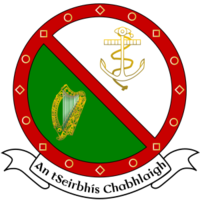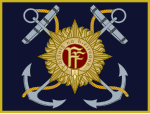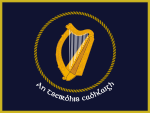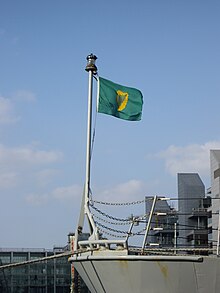Irish Naval Service
| Naval Service An tSeirbhís Chabhlaigh | |
|---|---|
 Emblem of the Naval Service | |
| Founded | 1 September 1946[1] |
| Country | |
| Size | 1,058 personnel[2] 7 ships (2 under construction) |
| Part of | |
| Naval Base | Haulbowline, County Cork, Ireland |
| Colors |   |
| Commanders | |
| Flag Officer Commanding the Naval Service (FOCNS) | Commodore Hugh Tully |
| Insignia | |
| Naval ensign |  |
| Naval jack |  |
The Naval Service (Irish: an tSeirbhís Chabhlaigh) is the maritime force of Ireland and is one of the three standing branches of the Irish Defence Forces.[3] Its base is in Haulbowline, County Cork.
All current Naval Service vessels are named with traditional Irish female names, taken from history and Celtic mythology. However, the next two ships in the fleet, the LÉ Samuel Beckett (to be commissioned in 2014) and the LÉ James Joyce (to be commissioned in 2015) are named after famous Irish literary figures. The ship prefix LÉ stands for Long Éireannach, "Irish ship" in the Irish language.
History

Coastal and Marine Service
The Anglo-Irish Treaty of 1921 stipulated that the Irish Free State would be given responsibility to police its customs and fishing, while the United Kingdom would remain in control of Irish Waters. In 1923 the Coastal and Marine Service (CMS) was created, yet merely one year later it was disbanded.
During the Civil War, in August 1922, a ship belonging to the British & Irish Steam Packet Company, the Lady Wicklow, led by Captain Patrick Ryan, was used to bring Irish National Army troops around the coast to Fenit, the port of Tralee in County Kerry. This naval involvement technically preceded the foundation of the Irish state, as Ireland was still part of the UK at the time.[4] Built in 1890 in Dublin Dockyard, the ship measured 262 feet by 34 feet. In all 450 troops, including officers, were landed. Tralee was later captured from local republican forces.
The Muirchú, formerly the British armed steam yacht Helga,[5] which had been used by the Royal Navy to shell Dublin during the 1916 rising, was the only CMS ship during this period. The CMS ship "Muirchu" continued to patrol Irish fisheries. Muirchu was re-armed in 1936 and purchased by the Irish government on advice of members of the later named Maritime Institute of Ireland for fisheries protection.
In 1937, the Irish Free State came to an end, and the sovereign and current independent state of Ireland replaced it. The following year, the United Kingdom handed over three "treaty" ports (Cork Harbour, Bere Haven and Lough Swilly). Consequently, the Royal Navy withdrew from Cork Harbour in July 1938. The "Fort Rannoch" was added to the Irish fleet at that time.
In 1939 the Irish Government ordered two Motor Torpedo Boats (MTBs) from Vospers UK. When World War II began in September 1939 the Marine and Coastwatching Service was set up. In order for Ireland to remain neutral, it became clear that a full naval service would be required. The government consequentially ordered an additional 4 MTBs. By the end of 1940 the Irish Marine and Coastwatching Service consisted of 6 MTB's and 4 other assorted craft.
During the War the Service regulated merchant ships, protected fisheries, and laid mines off Cork and Waterford. By 1941 the Marine and Coastwatching Service consisted of 10 craft (6 MTBs plus 4 assorted vessels) and about 300 all ranks. In 1942 the Service was renamed the Marine Service.
Naval Service
In September 1946, the Marine Service was formally disbanded and the Naval Service established as a permanent component of the Irish Defence Forces. The Naval Service purchased three Corvettes from the United Kingdom in 1946 and 1947. The tradition of naming Irish Naval Ships after figures in Celtic Mythology began, and the ships were named Cliona, Maev and Macha. These three ships were to become a key part of the Naval Service in the 1950s and 1960s. The first formal training of Irish naval cadets took place at the Britannia Royal Naval College, Dartmouth, UK in 1947.[citation needed] In 1970, the Cliona and Macha were withdrawn from service and scrapped, leaving the Maev as the sole ship in the Naval Service. The Maev was withdrawn from service in 1972.[6] In 1971, the Naval Service commissioned three armed minesweepers: Grainne, Banba and Fola.

In 1971 the Naval Service commissioned Verlome Cork Dockyard to build an offshore patrol ship. Named the LÉ Deirdre, it was the first naval vessel purpose-built in Ireland to patrol its waters. The Economic Exclusion Zone of Ireland was increased in 1976 from 12 to 200 miles. The subsequent strain put on the Naval Service prompted funding from the European Economic Community to build five further ships, four of which were eventually built. Meanwhile the former Irish Lights vessel Isolda was purchased to act as a training ship, bearing the pennant number A15 and renamed LÉ Setanta. It served until being sold for scrap in 1984. A Danish stern trawler Helen Basse was also leased for a year, serving under the name LÉ Ferdia, pennant number A16.[7]
The 50th anniversary of the Naval Service took place in 1996. Celebrations included a fleet review by President Mary Robinson. In 1999, a new ship LÉ Róisin was delivered to the Navy, marking the beginning of a new class of larger patrol vessels. The most recent addition to the fleet has been LÉ Niamh, commissioned in September 2001.
While most missions undertaken by the Naval Service are in Irish waters, on occasion longer missions are undertaken in support of Irish Peacekeepers serving with the United Nations, representing Ireland, or in support of Irish trade missions. In 2002, LÉ Niamh delivered supplies to Irish troops in Eritrea, then continued on a trade promotional tour to India, Malaysia, Singapore, Hong Kong, China, Korea, and Japan, becoming the first Irish naval vessel to cross the Equator. In 2006 LÉ Eithne travelled to Argentina, attending ceremonies connected with the 149th anniversary of the death of Irish-born Admiral William Brown, founder of the Argentine Navy, and also visited ports in Uruguay and Brazil. In 2010, the Niamh travelled to the Americas, visiting Brazil, Argentina, Chile, Mexico and the United States.
Currently, two new ships are planned for the Naval Service. The first, LÉ Samuel Beckett, is scheduled to be delivered by February 2014 to replace LÉ Emer, followed a year later by LÉ James Joyce which will replace LÉ Aoife. The new ships will displace over 1,900 tons, have a top speed of 23 knots, a range of 6,000 nautical miles. They will be armed with an OTO Melara 76/62, and will have a longer deck area that will accommodate deep-sea search-and-rescue submarines and unmanned aircraft.[8]
Assets
Current strength


Its current strength is seven offshore patrol vessels:
- Emer Class Offshore Patrol Vessels
- LÉ Aoife (P22) (commissioned 1979)
- LÉ Aisling (P23) (commissioned 1980)
- Eithne Class Offshore/Helicopter Patrol Vessel
- LÉ Eithne (P31) (flagship, commissioned 1984)
- Peacock Class Coastal Patrol Vessels
- LÉ Orla (P41) (commissioned 1988)
- LÉ Ciara (P42) (commissioned 1988)
- Róisín Class Offshore Patrol Vessels
- LÉ Róisín (P51) (commissioned 1999)
- LÉ Niamh (P52) (commissioned 2001)
- Samuel Beckett Class Offshore Patrol Vessels
- LÉ Samuel Beckett (P61) (awaiting commission)
- LÉ James Joyce (P62) (under construction)
Other assets
The Naval Service also operates smaller training vessels and rigid-hulled inflatable boats.
Air assets to support naval patrols are provided by the Air Corps with their two CASA CN-235 maritime patrol aircraft and AW139 helicopters operated from Baldonell Aerodrome in County Dublin.
There are currently 1,444 personnel of all ranks in the Naval Service plus 200 in the Naval Service Reserve. LÉ Eithne is the current flagship of the Naval Service.
Non-Military training takes place alongside Mercantile Marine Personnel at the National Maritime College of Ireland in Ringaskiddy, near to the Haulbowline base.[9]
Acquisitions and future
In October 2010, contracts were signed for two new "Offshore Patrol Vessels" (OPVs), with an option for a third. The OPVs are under construction by Babock Marine in the UK to STX Marine's PV 90 design. The first ship, LÉ Samuel Beckett, was launched in November 2013 to be delivered in 2014. The second ship, LÉ James Joyce, was laid down in November 2013, with delivery expected in February 2015.[10]
The Naval Service is also investigating a "Multi-Role Vessel" (MRV) of up to 130 metres and costing in the region of €90 Million[needs update]. Such a vessel would improve the supply of overseas UN missions and could contribute to the Nordic Battle Group.[11] Leading contenders for the MRV design include the Danish Absalon class flexible support ship and a version of the German Navy MEKO 200 design.[12]
It has also been reported that an "Extended Patrol Vessel" (EPV) may also be purchased for the Naval Service, with an option on a second[needs update]. If these purchases were to go ahead, at least one would replace the planned MRV purchase.[13] An EPV can be considered as a Corvette type navel vessel, with a similar shape and role to the smaller OPV, but its increased size would allow it to carry out a broader range of operations in more extreme weather in the North Atlantic.[citation needed]
Decommissioned
The following vessels have served in the Service's fleet:[14]

- LÉ Macha (01) (1946–1970)
- LÉ Maev (02) (1946–1972)
- LÉ Cliona (03) (1947–1970)
- LÉ Setanta (A15) (1976–1984)
- LÉ Ferdia (A16) (1977–1978)
- LÉ Grainne (CM10) (1971–1987)
- LÉ Banba (CM11) (1971–1984)
- LÉ Fola (CM12) (1971–1984)
- LÉ Deirdre (P20) (1972–2001)
- LÉ Emer (P21) (1978–2013)
Roles and Capabilities
The Naval Service's military roles and the functions it carries out are those of a coast guard rather than that of a conventional Navy.[citation needed] The Naval Service's ability to control Ireland's territorial waters and provide close naval support is extremely limited.[original research?] Sea lift is also limited and ad hoc.[citation needed] The Naval Service's non-military capabilities in aid to the civil power and other Government departments is almost exclusively fishery protection but also include search and rescue, drugs interdiction and dive support.
Irish territorial waters and EEZ
Since the 1960s Ireland has seen its jurisdiction over the North Atlantic extend from 3 nautical miles (pre-1967) to 12 nautical miles (pre-1990s). This was increased to 200 nautical miles again in 1994 when the introduction of the exclusive Economic Zone (EEZ) gave approval to the 1982 United Nations Convention on the Law of the Sea (UNCLOS). This convention grants the state sovereign rights over the seabed, its subsoil and the water adjacent to the seabed within the 200 nautical mile limit.
Negotiations are taking place that could see the influence of coastal states extended beyond the 200 nautical miles of EEZs.[citation needed] Part VI of UNCLOS concerns a coastal state's continental shelf out to 350 n miles from the coastline. In 2007, Ireland became the first country to gain approval for the extension of its continental shelf, to the west of the island, and now has responsibility for an area of some 141,000 square nautical miles – an increase of 100 per cent.[citation needed]
Diving section
The Naval Service has a specialist diving unit called the Naval Service Diving Section, which was established in the 1960s.[15] They have conducted combat diving training for Ranger candidates after selecting combat diving as a speciality.[16]
Among the tasks mandated to the NSDS include the following:[15]
- Search and Recovery
- Underwater Survey
- Explosive Ordnance Disposal
- Underwater Engineering
- Military Diving Training
Ranks
| Equivalent NATO Code | OF-6 | OF-5 | OF-4 | OF-3 | OF-2 | OF-1 | OF(D) | |
|---|---|---|---|---|---|---|---|---|
Ireland |

|

|

|

|

|

|

|

|
| Irish | Ceannasóir | Captaen | Ceannasaí | Leifteanant-Cheannasaí | Leifteanant | Fo-Leifteanant | Meirgire | Dalta |
| English | Commodore | Captain | Commander | Lieutenant Commander | Lieutenant | Sub Lieutenant | Ensign | Officer Cadet |
| Equivalent NATO Code | OR-9 | |||
|---|---|---|---|---|
Ireland |
 Executive |
 Administrative |
 Engineering |
 Communications |
| Irish | Oifigeach Barántais | |||
| English | Warrant Officer | |||
| Equivalent NATO Code | OR-8 | OR-7 | OR-6 | OR-5 | OR-4 | OR-3 | OR-2 | OR-1 |
|---|---|---|---|---|---|---|---|---|
Ireland |

|

|

|

|

|

|

|
No Insignia |
| Irish | Ard-Mhion-Oifigeach Sinsearach | Ard-Mhion-Oifigeach | Mion-Oifigeach Sinsearach | Mion-Oifigeach | Mairnéalach Ceannais | Mairnéalach Ábalta | Mairnéalach | No equivalent |
| English | Senior Chief Petty Officer | Chief Petty Officer | Senior Petty Officer | Petty Officer | Leading Seaman | Able Seaman | Ordinary Seaman | Recruit |
See also
Footnotes
- ^ "The Defence Forces". Irish Defence Forces. Retrieved 24 April 2014.
- ^ "Department of Defence and Defence Forces Annual Report 2012" (PDF). Department of Defence and Defence Forces. 2013. p. 21.
- ^ The Irish Defence Forces are made up of the Permanent Defence Forces (PDF) – the standing branches – and the Reserve Defence Forces (RDF). The Naval Service is part of the PDF.
- ^ Articles of Agreement between Great Britain and Ireland, 6 December 1921 (Irish Free State established pursuant thereto on 6 December 1922)
- ^ "History of the Maritime Institute of Ireland – Page 2". Retrieved 1 October 2009.
- ^ RTE documentary: "The Navy"
- ^ "Ships – history", Irish Defence Forces website
- ^ By Sean O’Riordan (24 May 2012). "Navy ships to carry deep sea robot subs". Irish Examiner. Retrieved 24 April 2014.
- ^ "History of Nautical Training in Ireland". National Maritime College of Ireland. Retrieved 24 April 2014.
- ^ "Irish OPV build makes progress". ihs.com. Retrieved 8 October 2013.
- ^ "New Naval Service vessels". inshore-ireland.com. Retrieved 17 March 2012.
- ^ St Patrick's Day (2 May 2006). "Navy chiefs set their sights on two new ships – National News". Independent.ie. Retrieved 17 March 2012.
- ^ Riegel, Ralph; Lavery, Don (11 September 2009). "Minister wants €104m to buy new boats for Navy". Irish Independent.
- ^ "History; Naval Service". Irish Defence Forces. Retrieved 24 April 2014.
- ^ a b "Naval Service Specialists – Diving Section". Irish Naval Service. 2009. Retrieved 1 October 2009.
- ^ "Special Operations' Irish Army Rangers Combat Diving Page". Retrieved 1 October 2009.
